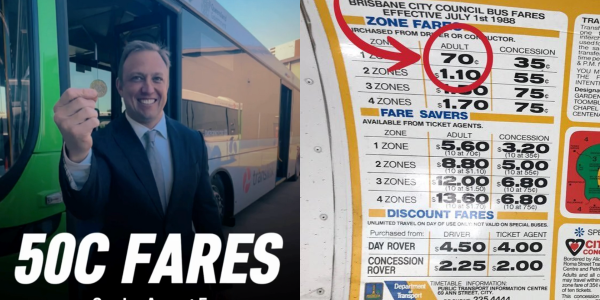Aussies can avail ‘almost free’ prices for this essential service: ‘Cheaper than it was in 1988’
By
Seia Ibanez
- Replies 8
Queenslanders are being greeted with a wave of nostalgia and relief as the state government announces a significant reduction in public transport fares, making them 'almost free' and cheaper than they were over thirty years ago.
Starting next week, Queensland residents will be able to travel across the Translink network – which includes buses, trains, ferries, and trams—for just 50 cents a trip.
This six-month trial is part of the Queensland government's initiative to ease the cost-of-living pressures that have been mounting for Australians.
Premier Steven Miles has highlighted that this price drop will take fares back to a time when a bus ticket costs at least 70 cents.

‘We’re making public transport cheaper than it was in 1988,’ Miles said.
‘Back then, a bus ticket set you back at least 70 cents.’
The announcement has been met with a mix of surprise and delight, as it's not every day that we hear prices going down, particularly in an era where the cost of living seems to be rising constantly.
To put things into perspective, let's take a stroll down memory lane and compare the prices of some everyday items from 1988 to today.
In 1988, the median house price in Brisbane was $71,000. Fast-forward to today and that figure has skyrocketed to an eye-watering $859,240.
Similarly, a loaf of white sliced bread that once cost $1.01 now costs about $4.40. Milk, potatoes, and other staples have all seen their prices climb over the years, with inflation not adjusted for these comparisons.
Speaking of inflation, it has been a hot topic recently, jumping to four per cent in the year to May, up from 3.6 per cent in April.
Economists are keeping a close eye on the latest data, predicting that the Reserve Bank of Australia may hike interest rates again if inflation persists.
This makes the Queensland government's fare reduction even more significant, providing some much-needed financial respite.
In contrast to Queensland's fare reduction, NSW residents have faced a 3.6 per cent increase in Opal card prices this month, marking the second hike in the last 12 months.
In addition to the reduced public transport costs, Queenslanders have also received a $1,000 energy rebate applied this month, and drivers can look forward to a 20 per cent reduction in car registration fees starting 5 August.
These measures are part of a broader strategy to support households during these challenging economic times.

Will the reduced fares encourage you to use public transport more often? Do you remember the prices of everyday items back in 1988? Share your stories and experiences in the comments below!
Starting next week, Queensland residents will be able to travel across the Translink network – which includes buses, trains, ferries, and trams—for just 50 cents a trip.
This six-month trial is part of the Queensland government's initiative to ease the cost-of-living pressures that have been mounting for Australians.
Premier Steven Miles has highlighted that this price drop will take fares back to a time when a bus ticket costs at least 70 cents.

Queensland will now pay 50 cents for their transport fares. Credit: @stevenmilesmp / TikTok and @StevenJMiles / Twitter
‘We’re making public transport cheaper than it was in 1988,’ Miles said.
‘Back then, a bus ticket set you back at least 70 cents.’
The announcement has been met with a mix of surprise and delight, as it's not every day that we hear prices going down, particularly in an era where the cost of living seems to be rising constantly.
To put things into perspective, let's take a stroll down memory lane and compare the prices of some everyday items from 1988 to today.
In 1988, the median house price in Brisbane was $71,000. Fast-forward to today and that figure has skyrocketed to an eye-watering $859,240.
Similarly, a loaf of white sliced bread that once cost $1.01 now costs about $4.40. Milk, potatoes, and other staples have all seen their prices climb over the years, with inflation not adjusted for these comparisons.
Speaking of inflation, it has been a hot topic recently, jumping to four per cent in the year to May, up from 3.6 per cent in April.
Economists are keeping a close eye on the latest data, predicting that the Reserve Bank of Australia may hike interest rates again if inflation persists.
This makes the Queensland government's fare reduction even more significant, providing some much-needed financial respite.
In contrast to Queensland's fare reduction, NSW residents have faced a 3.6 per cent increase in Opal card prices this month, marking the second hike in the last 12 months.
In addition to the reduced public transport costs, Queenslanders have also received a $1,000 energy rebate applied this month, and drivers can look forward to a 20 per cent reduction in car registration fees starting 5 August.
These measures are part of a broader strategy to support households during these challenging economic times.
Key Takeaways
- Public transport fares in Queensland will be reduced to 50 cents across the Translink network as part of a cost-of-living support trial.
- This reduction makes fares cheaper than what they were in 1988, not accounting for inflation, according to Premier Steven Miles.
- The trial for almost free public transport will last for six months and is not restricted by location or distance.
- Alongside transport cost reductions, Queenslanders have received a $1,000 energy rebate and will get a 20per cent discount on car registration fees starting August 5.
Will the reduced fares encourage you to use public transport more often? Do you remember the prices of everyday items back in 1988? Share your stories and experiences in the comments below!







